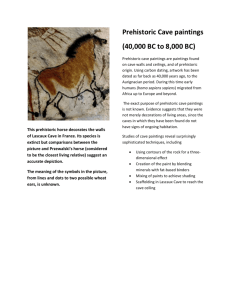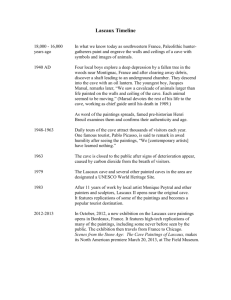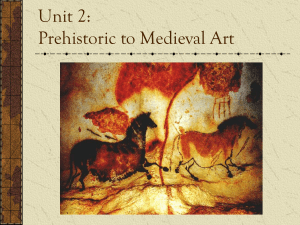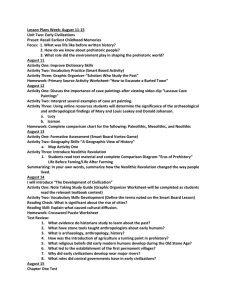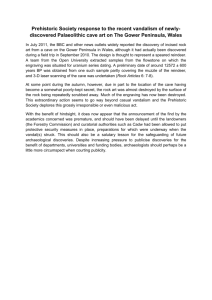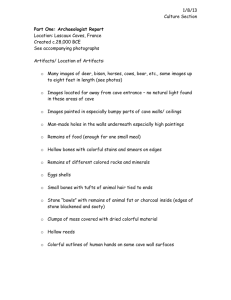Lesson Plan
advertisement
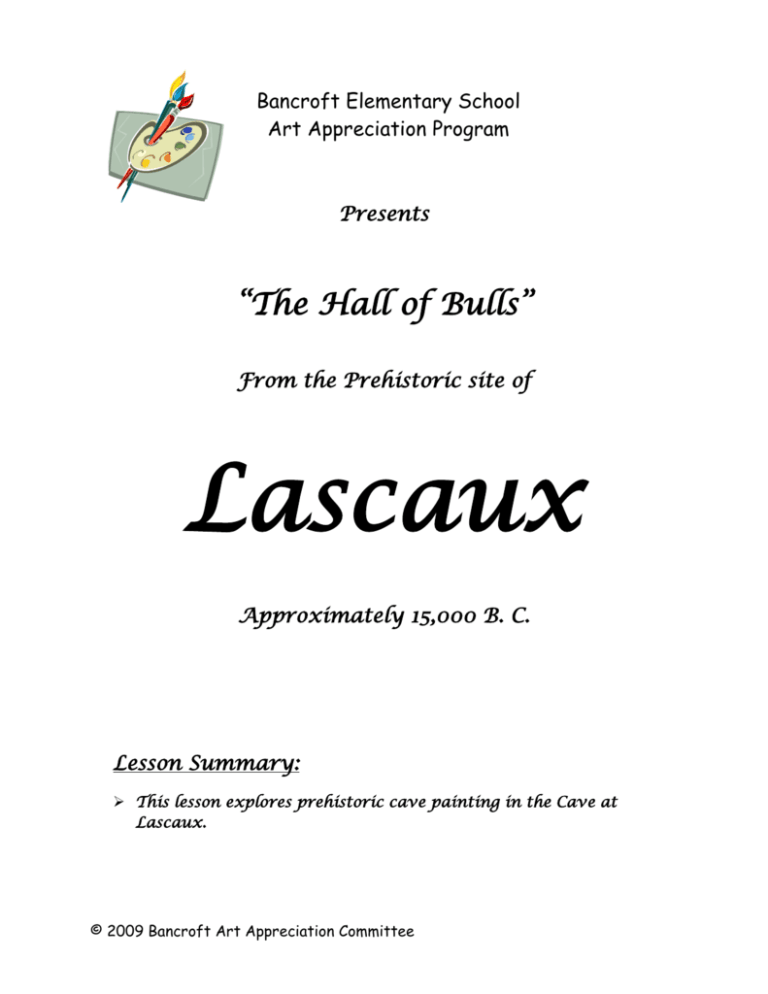
Bancroft Elementary School Art Appreciation Program Presents “The Hall of Bulls” From the Prehistoric site of Lascaux Approximately 15,000 B. C. Lesson Summary: This lesson explores prehistoric cave painting in the Cave at Lascaux. © 2009 Bancroft Art Appreciation Committee VOLUNTEER CHECKLIST Lesson Information Artist: Cave at Lascaux (@15,000 BC) Art Title: “The Hall of Bulls” Period or Style: Prehistoric Art Element: Texture Project/Medium: Sand paper paintings with earth tones. Prep-work Required Discussion: Familiarize yourself with current lesson details Presentation Materials Images “Black Cow” “Hall of the Bulls’, “The unicorn” On drive in Cabinet Prints/Scannings: Cave Art Prints/Student Examples In folder Lesson Plan: Lascaux (site) In folder Book: Discovery in the Cave In folder Activity Materials Sand paper 1 sheet per student Tempera paint in black, red, yellow and brown on paper plates Small amounts of each Brushes, water cups, and paper towels, newspaper to cover tables Enough to share © 2009 Bancroft Art Appreciation Committee 2 LASCAUX LESSON PLAN Objectives To introduce students to art created in Prehistoric times. To create a piece of ‘cave’ art using simple lines and natural earth tone colors. Presentation Timing With Upper Grade students, your discussion time may be a bit longer than with the lower grades. Spend 15 minutes on the discussion portion and 45 minutes on the art activity. Share with student’s important facts from the lesson plan and if desired read from Discovery in the Cave. Prehistoric Art (Show pictures of Lascaux while discussing) Prehistoric is before any written language was available to record history. Cave painting was the earliest art form in history (or at least the most studied and recognized as art to our modern sensibilities of what ‘art’ is) and also the longest art movement in history. The time period was 33,000B.C-11,000B.C. lasting between 20,000-25,000 years. The people creating the art were Humans that looked just as we do now. These humans were Homo sapiens originally from East Africa. They had knowledge of fire and often sought shelter in the mouths of caves. They also hunted animals for food as well as gathering wild berries and nuts and greens. The techniques used in these caves were painting or engraving. They made paint from rocks and minerals found around the area and ground into powders and mixed with water. The colors they used were natural earth tones, mostly black, red and yellow. © 2009 Bancroft Art Appreciation Committee 3 They used sticks or brushes made from animal hair. They would also use charcoal sticks. By the light of crude stone lamps filled with animal fat (oil), they constructed scaffolding that allowed them to decorate the high, rough walls. Although we tend to think of ‘cave people’ as savages or uncivilized people, they were actually fine artists! These paintings in the caves in the south of France and north of Spain are the first evidence of humans creating a ‘picture’ of anything. After this humans have never stopped! To cover large areas they might blow paint out onto the wall with a hollowed tube. Often the artist would show a handprint, which was done by blowing the pigment onto their hand on the wall leaving the outline behind. This may have been their ‘signature’ in lieu of no language to write a name. These paintings were mainly of animals that were part of their lives but also were decorative with geometric signs. The Cave at Lascaux In 1940 four teenage boys in France were looking for their dog that had run ahead in the wooded area of Lascaux. They heard barks coming from a hole and discovered he had fallen in. They came back with a rope and flashlights and saw that it wasn’t just a hole it was a cave. That cave they discovered holds the most elaborate prehistoric art found to date. The walls and ceilings of the caves are decorated with some 600 painted figures and almost 1,500 engravings in total. The subjects of the paintings are almost entirely animals, some of which are now extinct. There are horses, deer, bulls, bison, wild cats and a mythical creature referred to as the unicorn. There are also many dots and lines and rectangular grids. The biggest area is the Hall of the Bulls’ which has a scene, which is obviously well planned out. This was probably a public area for ceremonies of music and © 2009 Bancroft Art Appreciation Committee 4 chanting. The Hall of the Bulls is a masterpiece with bold animal figures thundering across the ceiling. It also includes the largest animal ever seen in cave art-a bull that is 17 long! This room was easy to access and could accommodate up to 50 people for ceremonies. The rest of the cave is not for public view and hard to get to yet has most of the paintings and carvings. The art done in the rest of the cave was simply for the purpose of drawing what ever was in the mind of the artist. At the time of discovery in 1940 the caves had been sealed for 17,000 years and were in perfect condition. . Unfortunately, however, the caves were opened to an enthusiastic public in 1948 without any thought to preservation. The combined effects of artificial lighting and 100,000 visitors per year soon caused great damage to the site. Much valuable archaeological information was lost, the bright colors of the paintings faded, and destructive layers of algae, bacteria and opaque calcite crystals formed on the walls. Finally, in 1963, the caves were closed to the public and restoration efforts began. The growth of crystals was stopped and the algae and bacteria growth was reversed. The caves are still carefully monitored and remain closed to the public. In 1979, the Lascaux Caves were declared a World Heritage Site along with over 20 other painted caves in the area. In 1983, a carefully executed replica known as Lascaux II opened to the public. Located on the same hill as the original, the replica cave took 10 years to complete. A local artist named Monique Peytral reproduced the paintings with painstaking attention to detail. © 2009 Bancroft Art Appreciation Committee 5 Art Activity Discuss the stylization of the horses, bulls, figures and symbols analyzing their skinny legs and their body forms and relate them to geometric shapes. Students look at the sample art project while listening to instructions. Emphasize that the student’s art will look different and unique because their personality will show in their own piece. Each student will paint on a piece of sand paper which will be rough like the wall of the cave. Have paper plate palettes out with black, red, brown and yellow. They can mix two colors together if they want. Discourage too much mixing. Starting with black paint have students paint an outline of a bull or horse on their paper. It may help to have a simple drawing on the white board. Have students use natural, earth tone colors. They may want to mix in a few drops of water (from their brush) to thin the paint. Then the students paint the inside of the animal with a color of their choice. Remind students to rinse brush after each color. Encourage them to add some other background elements to their painting like a sun-arrows-dots-lines etc. Let pieces dry thoroughly on drying rack and return to pick up and store safely for the year until you compile their portfolios. (Optional) With teacher cooperation consider creating a cave with all the artwork up in a supply room or other small area that can be made dark and let the kids come a few at a time with flashlights. Maybe invite 1st and 2nd graders to the cave at B-4! If students are interested in further information about the Lascaux cave site, the can see a virtual tour at the following website: www.lascaux.culture.fr © 2009 Bancroft Art Appreciation Committee 6


